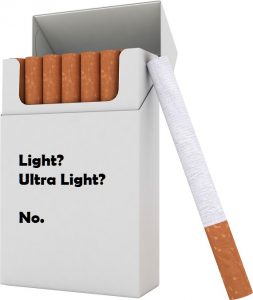 July 22, 2010, marks another milestone in tobacco control and prevention. As of that date, the law prohibits the tobacco industry from distributing or introducing into the U.S. market any tobacco products for which the labeling or advertising contains the descriptors “light,” “low,” “mild,” or any similar descriptor, irrespective of the date of manufacture. However, consumers may continue to see some products with these descriptors for sale in stores after July 22, because retailers are permitted to sell off their inventory.
July 22, 2010, marks another milestone in tobacco control and prevention. As of that date, the law prohibits the tobacco industry from distributing or introducing into the U.S. market any tobacco products for which the labeling or advertising contains the descriptors “light,” “low,” “mild,” or any similar descriptor, irrespective of the date of manufacture. However, consumers may continue to see some products with these descriptors for sale in stores after July 22, because retailers are permitted to sell off their inventory.
Cigarettes labeled “light,” “low,” or “mild” are often called “low-yield” because they deliver less than 15 mg of tar when measured on a standardized smoking machine. After a 1964 historic Surgeon General’s report on smoking and health, cigarette manufacturers made changes in cigarette design to achieve and promote low-yield cigarettes (e.g., filters, ventilation holes, chemical additives). Advertisements implied that the low-yield cigarettes were safer than regular cigarettes. However, there is no convincing scientific evidence to indicate that low-yield cigarettes are safe. No cigarette design changes have resulted in a decrease in the diseases caused by smoking.
Prohibiting the use of terms like “light,” “low,” and “mild” is an important step to help protect the public health. Many smokers mistakenly believe that cigarettes marketed with these descriptors cause fewer health problems than other cigarettes. Studies have found that smokers who use light cigarettes do not reduce their risk for developing smoking-related cancers and other diseases, that switching to light cigarettes does not help smokers quit, and that switching to light cigarettes may actually decrease the motivation to quit. All cigarettes are harmful to health—regardless of their taste, smell, label, or packaging color. There is no such thing as a safe cigarette.
For more information visit http://www.cdc.gov/